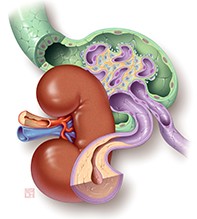Peer Reviewed
Feature Article Endocrinology and metabolism
Diabetic nephropathy: the good, the bad and the ugly
Abstract
Diabetic nephropathy is a common disorder with a variable presentation and course. Aggressive treatment of risk factors (hyperglycaemia, hypertension and dyslipidaemia) can slow progression of this condition, as illustrated by three patients whose disease courses differ widely.
Key Points
- Diabetic nephropathy is becoming more common in general practice; around one-third of patients with diabetes have nephropathy.
- Patient presentations with diabetic nephropathy vary, and progression depends on control of risk factors.
- Progression is slowed by good control of hypertension, use of ACE inhibitors, good glycaemic control and proteinuria reduction.
- Newer agents exist for diabetic control but glycaemic control that is too tight can be as harmful as control that is too loose.
- Patients with diabetic nephropathy should be specifically assessed for acid–base and electrolyte disorders.
Picture credit: © KO Studios.
Purchase the PDF version of this article
Already a subscriber? Login here.

